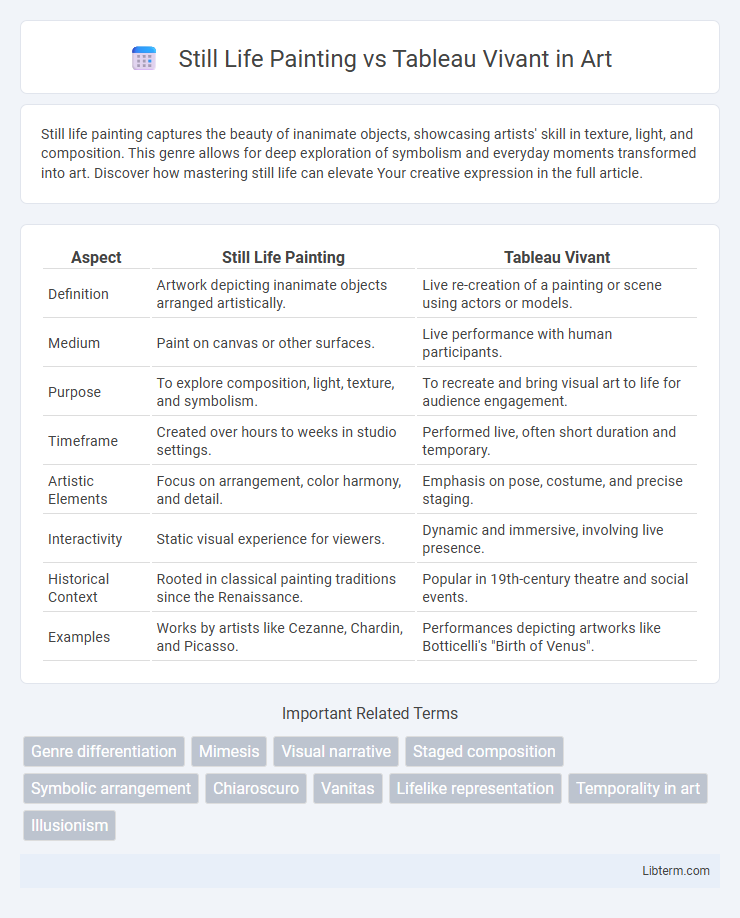Still life painting captures the beauty of inanimate objects, showcasing artists' skill in texture, light, and composition. This genre allows for deep exploration of symbolism and everyday moments transformed into art. Discover how mastering still life can elevate Your creative expression in the full article.
Table of Comparison
| Aspect | Still Life Painting | Tableau Vivant |
|---|---|---|
| Definition | Artwork depicting inanimate objects arranged artistically. | Live re-creation of a painting or scene using actors or models. |
| Medium | Paint on canvas or other surfaces. | Live performance with human participants. |
| Purpose | To explore composition, light, texture, and symbolism. | To recreate and bring visual art to life for audience engagement. |
| Timeframe | Created over hours to weeks in studio settings. | Performed live, often short duration and temporary. |
| Artistic Elements | Focus on arrangement, color harmony, and detail. | Emphasis on pose, costume, and precise staging. |
| Interactivity | Static visual experience for viewers. | Dynamic and immersive, involving live presence. |
| Historical Context | Rooted in classical painting traditions since the Renaissance. | Popular in 19th-century theatre and social events. |
| Examples | Works by artists like Cezanne, Chardin, and Picasso. | Performances depicting artworks like Botticelli's "Birth of Venus". |
Introduction to Still Life Painting and Tableau Vivant
Still life painting captures inanimate objects arranged to emphasize texture, light, and composition, historically rooted in Flemish and Dutch art traditions. Tableau vivant, or "living picture," involves live actors posing motionlessly to recreate scenes from literature, art, or everyday life, popularized in 19th-century European theatre and photography. These art forms differ fundamentally, with still life focusing on static objects and tableau vivant emphasizing human presence and theatrical representation.
Historical Origins and Evolution
Still life painting originated during the Renaissance, emphasizing the meticulous depiction of inanimate objects symbolizing themes like mortality and abundance, with roots in ancient Roman art. Tableau vivant, emerging in the 19th century, involved live participants posing motionlessly to recreate scenes from literature, history, or art, blending performance with visual storytelling. Both forms evolved to explore representation and narrative, influencing modern artistic and theatrical expressions.
Key Characteristics of Still Life Painting
Still life painting emphasizes the detailed representation of inanimate objects such as fruits, flowers, and household items, highlighting texture, light, and composition. This art form allows artists to explore symbolism, meticulous arrangements, and color contrasts to convey deeper meanings or aesthetic appeal. Unlike tableau vivant, which involves live human models posing to recreate scenes, still life paintings focus solely on static objects without human presence.
Defining Features of Tableau Vivant
Tableau vivant, characterized by live participants posed to create a static scene, emphasizes theatricality and human expression, contrasting with still life painting's focus on inanimate objects arranged for visual composition. The defining features of tableau vivant include live performers mimicking artistic scenes without movement or speech, creating a vivid, temporal representation of a work of art or narrative. This performance art uniquely combines visual art and live theater, engaging audiences through dynamic embodiment rather than painted depiction.
Techniques and Artistic Approaches
Still life painting employs meticulous brushwork and controlled lighting to capture inanimate objects with high detail, emphasizing texture, composition, and color harmony. Tableau vivant uses live models and staged scenes to convey narrative and emotion through movement, posture, and spatial arrangement, integrating elements of theater and performance art. The artistic approach in still life focuses on static representation to explore symbolism and aesthetics, while tableau vivant emphasizes dynamic expression and temporal experience.
Symbolism and Meaning in Both Forms
Still life painting captures symbolic meanings through carefully arranged objects, conveying themes such as mortality, abundance, or spirituality by embedding cultural and historical references within inanimate compositions. Tableau vivant, as a live representation of art or scenes, uses human presence and gesture to embody symbolic narratives and evoke emotional engagement, often dramatizing moral or allegorical messages. Both forms rely on visual symbolism, yet still life emphasizes static contemplation of objects' intrinsic meanings, while tableau vivant enacts dynamic storytelling through embodied symbolism.
Cultural and Social Contexts
Still life painting traditionally symbolizes cultural values of permanence and material wealth, reflecting social hierarchies through carefully arranged objects such as fruits, flowers, and luxury items. Tableau vivant, by contrast, embodies performative social interactions and communal storytelling, often used in European salons as a means to reinforce collective identity and historical narratives through live, staged scenes. Both art forms serve as cultural mirrors, with still life emphasizing stability and material culture, while tableau vivant captures dynamic social engagement and historical reenactment.
Comparison of Aesthetic Impact
Still life painting emphasizes meticulous attention to detail, composition, and lighting to evoke a contemplative, static beauty that invites prolonged viewer interpretation. Tableau vivant, by contrast, uses live models in staged scenes to create a dynamic, immersive experience that captures ephemeral emotions and the interplay of space and movement. The aesthetic impact of still life lies in its timeless, symbolic qualities, whereas tableau vivant's immediacy and theatricality provoke a more visceral, emotional response.
Modern Interpretations and Influence
Modern interpretations of still life painting incorporate mixed media and digital elements, expanding traditional compositions to explore themes of consumer culture and environmental concerns. Tableau vivant has evolved into performance art that emphasizes multimedia integration and interactivity, reflecting contemporary social narratives and identity politics. Both forms influence each other by blending static visual art with dynamic human presence, shaping innovative artistic expressions in galleries and digital platforms.
Conclusion: Choosing Between Still Life and Tableau Vivant
Choosing between still life painting and tableau vivant depends on the desired artistic expression and interaction with the subject. Still life offers detailed control over composition, lighting, and symbolism, emphasizing permanence and meticulous observation. Tableau vivant introduces performative elements and dynamic storytelling, engaging living models to create temporal, immersive scenes that capture momentary emotions and narratives.
Still Life Painting Infographic

 libterm.com
libterm.com